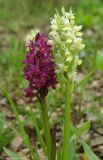Dactylorhiza romana ssp. georgica |
   | Dactylorhiza romana ssp. georgica Пальчатокоренник желтоватый |
В списке-первоисточнике этот название считалось синонимом Dactylorhiza flavescens (K. Koch) Holub * – отсутствует в списке-первоисточнике. * – в списке-первоисточнике таксон имеет другой статус Показано с 1 по 2-е (2 из 2 найденных) вид romanaComparative morphological, anatomical and habitat studies on Dactylorhiza romana (Seb.) Soó subsp. romana and Dactylorhiza romana (seb.) Soó subsp. georgica (Klinge) Soó ex Renz & Taub. (Orchidaceae) in Turkey (www.researchgate.net)ПожаловатьсяIn this study, 2 subspecies; Dactylorhiza romana (Seb.) Soó subsp. romana and Dactylorhiza romana (Seb.) Soó subsp. georgica (Klinge) Soó ex Renz & Taub. mainly distributed in Turkey were investigated in terms of morphological, anatomical characters and habitat properties. Plant and soil samples of D. romana subsp. romana were taken from 9 localities and D. romana subsp. georgica from 7 localities in Turkey. We observed that some of morphological characters such as; underground part length, tuber length, the longest leaf width, and bract length had different properties between both subspecies. Cross sections of the leaves, stems, tubers and roots were taken by free-hand and stained with Sartur solution and Safranin. The same procedure was performed for the surface sections of leaves and stem. Stomatal and epidermal cells, starch granules dimensions, lengths of raphides, stomata index, and cuticular thickness were measured. Anatomical characters of leaves such as cuticle thickness and stomata index displayed between two subspecies. Although D. romana subsp. georgica grows in high altitudes, D. romana subsp. romana prefers lower altitudes. The most common habitat of D. romana is meadow, macchie and forest lands. We obtained that both of them had similar soil properties, while the differencies came out by habitat properties. Morphological and habitat characters were compared with independent-T test. Systematics and evolution of Dactylorhiza romana/sambucina polyploid complex (Orchidaceae) (www.researchgate.net)ПожаловатьсяThe European–Mediterranean–Oriental Dactylorhiza romana/sambucina polyploid complex was studied with regard to genetic and morphological variation patterns. Allozyme and morphometric data were collected from 24 and 19 populations, respectively, initially identified as D. flavescens, D. insularis, D. markusii, D. romana, D. sambucina, and an indeterminate taxon. Genetic distances were calculated and illustrated by an unweighted pair-group method using arithmetic averages (UPGMA) dendrogram, and principal components analyses (PCAs) were used to summarize morphological variation patterns. Another PCA was performed on combined allozyme and morphometric data. On the basis of the dendrogram and the PCA plots, main groups of populations were delimited, and the probability that each morphological character would distinguish correctly between these groups was estimated. After combining morphometric interpretations with studies of herbarium material and information from the literature, the following taxa were confidently accepted: D. romana ssp. romana, D. romana ssp. guimaraesii (comb. et stat. nov.), D. romana ssp. georgica, D. sambucina, D. cantabrica (sp. nov.), and D. insularis. Levels of genetic diversity suggest that D. romana s.s. is the least derived member of the complex. The evolutionary divergence of the diploid species, D. romana and D. sambucina, was probably the outcome of vicariant speciation, whereas D. romana ssp. georgica and D. romana ssp. guimaraesii appear to have evolved from D. romana s.s. through incomplete vicariant and peripheral isolate speciation events, respectively. In some populations of the diploid taxa, a significant deficiency in heterozygotes was found at one to three loci. It is proposed that this pattern may indicate a Wahlund effect, hypothesizing that local populations are subdivided into demes determined by the commonly sympatric occurrence of two distinct colour morphs combined with partial morph constancy of individual pollinators (bumblebees). Several pathways are possible for the origin of the allotriploid D. insularis and the apparently allotetraploid D. cantabrica. A taxonomic revision is provided. © 2006 The Linnean Society of London, Botanical Journal of the Linnean Society, 2006, 152, 405–434. Особенности антэкологии Dactylorhiza romana (Orchidaceae) в Крыму: распространение, фенология, пространственное размещение и морфометрия цветущих растений (ekosystems.cfuv.ru)ПожаловатьсяПроанализировано распространение орхидеи пальчатокоренника римского (Dactylorhiza romana) на
Крымском полуострове. На южном берегу Крыма (ЮБК) вид встречается на протяжении всего западного
южнобережья и только в двух пунктах на востоке восточного южнобережья (Карадаг). В зоне горных лесов Крыма
D. romana встречается только в западных частях южного и северного макросклонов крымских гор, при этом на
северном макросклоне этот вид поднимается до высоты 1100 м н.у.м. В предгорной зоне Крыма D. romana
встречается только на границе с зоной горных лесов – в трех отдельных локалитетах в западной части предгорий,
в одном – в центральной части и в трех – на крайнем востоке этой природной зоны. Фенодаты периода цветения
колеблются в зависимости от погодных условий сезона. Начало цветения – с 5 по 10 апреля, окончание – 10–20
мая. Фенодаты цветения южнобережных и горно-лесных ценопопуляций совпадают, при этом сумма
положительных температур начала цветения ценопопуляций на ЮБК составляет 650 °С, а в горных лесах – 200
°С. Распределение генеративных особей в двух местообитаниях в горных лесах Крыма (Осиновая балка) и на ЮБК
(гора Кастель) крайне неравномерно – от плотных скоплений, в которых расстояние между цветущими особями
измеряется 1–50 см, до разреженных с расстоянием между особями 1–3 м и более. Такое распределение сильно
отклоняется от нормального и представляет собой распределение «разломанного стержня» МакАртура.
Южнобережная и горно-лесная ценопопуляции D. romana достоверно отличаются по длине цветоносов, соцветий
и количеству цветков в соцветиях. Генеративные особи на горе Кастель по всем перечисленным параметрам
превосходят экземпляры из Осиновой балки. Растения из южнобережного локалитета так же характеризуются
бо́льшими величинами коэффициента вариации по большинству параметров. Существенные отличия в сумме
положительных температур, определяющих фенодаты периода цветения, а также морфологические отличия
растений южнобережной и горно-лесной ценопопуляций трактуются как наличие в Крыму двух экологических
форм D. romana. Dactylorhiza romana ssp. georgica (Klinge) Soó ex Renz & Taubenheim // Плантариум. Растения и лишайники России и сопредельных стран: открытый онлайн атлас и определитель растений. [Электронный ресурс] URL: https://www.plantarium.ru/page/view/item/12625.html (дата обращения: 21.12.2024). Dactylorhiza romana ssp. georgica (Klinge) Soó ex Renz & Taubenheim // Plantarium. Plants and lichens of Russia and neighboring countries: open online galleries and plant identification guide. URL: https://www.plantarium.ru/lang/en/page/view/item/12625.html (accessed on 21 Dec 2024). |










